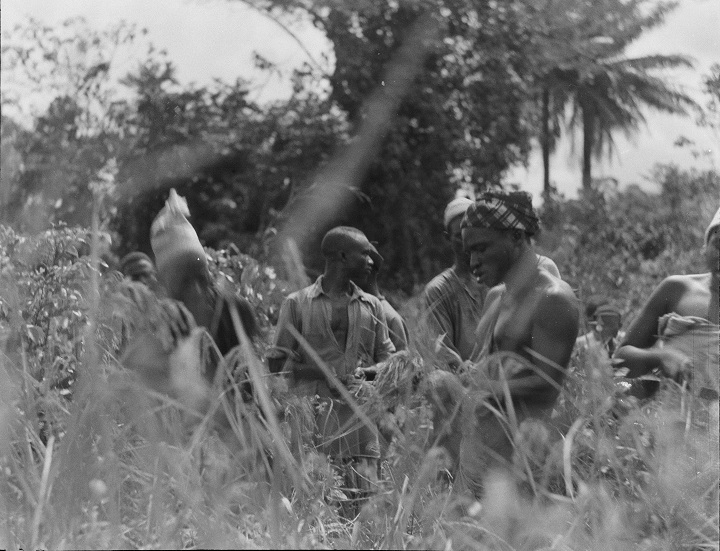Photographing Africa: Lessons from the Hofstra collection


This blog has been written by Cameron Stone. Cameron worked as an intern with the ASCL Library from September 2021 to February 2022. He is a History RMA student at Utrecht University, with interests in postcolonial African international relations.
In 1934, sociologist and anthropologist Sjoerd Hofstra would make the first of two visits to Sierra Leone, making him most likely the first Dutchman to conduct scientific fieldwork in Africa. Sjoerd Hofstra was an important academic in his day, holding numerous prestigious positions including director of the Institute of Social Studies, which he helped in founding in 1952. As one of the doctoral students of London-based anthropologist Bronisław Malinowski, his two visits saw him stay for almost two years among Mende people in the small village of Panguma, Kenema District, where he took hundreds of photographs. Hofstra’s stay in Panguma was primarily for the purpose of ethnographic research, yet both the photographs taken as well as his letters home illustrate that he was a warmly welcomed and accepted guest among Panguma’s inhabitants.

Over 400 photographs
Most of Hofstra’s photographs have ended up in the Hofstra collection here at the ASCL, and in the last few months of interning with the ASCL Library I have been lucky enough to work with them as part of a broader project of uploading them to Wikimedia Commons. Commons is a platform that allows users to upload any images (provided they have permission) and thus make them usable across all Wiki platforms, as well as accessible at no cost to the general public. We have just over 400 photographs taken by Hofstra in the form of prints from glass-plate positives. They depict a range of things - from ‘posed’ photographs of men in Falui or Bundu masks, to more candid representations of everyday life in Panguma. Hofstra was likely a far better academic than he was a photographer, but even among some of the blurriest or poorly lit photos one is able to view a snapshot of life in 1934 Panguma that is as intimate as it is revealing.
Ordinary life in a Sierra Leone village
 So why is the ASCL library taking the time to upload almost 90-year old photographs to the public domain? Commons is an enormous platform, with thousands of photographs uploaded on a daily basis. Why is it important that the ASCL contributes this drop in an ocean of online content? I would argue that it is hugely important that historical depictions of everyday life in Africa make their way into the public eye. Providing access to these representations of ordinary life in 1934 Panguma does much to balance a field of African imagery that is often dominated by negative representations. The Economist’s notorious 2000 cover lamenting a ‘hopeless Africa’ is just one example of how the most accessible African images are too-often ‘top-heavy’: depicting dictators or conflict. When ordinary people are portrayed, it is often through the lens of suffering from either poverty, disease or conflict. Hofstra’s photos, while far from professional, do much to portray all aspects of ordinary life in this Sierra Leonean village; from the mundanity of everyday tasks and work, the solemnity of a funeral service for a deceased relative of the chief, to the revelry of a young girls’ induction into the Sande society.
So why is the ASCL library taking the time to upload almost 90-year old photographs to the public domain? Commons is an enormous platform, with thousands of photographs uploaded on a daily basis. Why is it important that the ASCL contributes this drop in an ocean of online content? I would argue that it is hugely important that historical depictions of everyday life in Africa make their way into the public eye. Providing access to these representations of ordinary life in 1934 Panguma does much to balance a field of African imagery that is often dominated by negative representations. The Economist’s notorious 2000 cover lamenting a ‘hopeless Africa’ is just one example of how the most accessible African images are too-often ‘top-heavy’: depicting dictators or conflict. When ordinary people are portrayed, it is often through the lens of suffering from either poverty, disease or conflict. Hofstra’s photos, while far from professional, do much to portray all aspects of ordinary life in this Sierra Leonean village; from the mundanity of everyday tasks and work, the solemnity of a funeral service for a deceased relative of the chief, to the revelry of a young girls’ induction into the Sande society.
Destruction of memory
Sierra Leone’s own decade-long civil war devastated the country in ways that have been documented by many, but perhaps less-documented is the destruction of local and popular memory, particularly amongst small villages of just a few thousand like Panguma. Panguma is situated close to the border with Liberia, which hosted and supported belligerents in the civil war. Andrea Stultiens, who completed her PhD in photography at Leiden University and worked in digitalising many photos taken in Sierra Leone at the time by a range of photographers, revealed to me that the masks and costumes captured in the photographs have since been lost or destroyed in conflict. There is further value, then, in that these photographs capture and ‘memorialise’ that which has since been lost.
 Accessible platform
Accessible platform
Wikimedia Commons is the ideal platform for this exercise, providing accessibility in two senses. The images are free for others to view and use themselves, with no obstructive paywalls. Secondly, and perhaps more importantly, the images can be uploaded in a ‘high-resolution, low-quality’ format which enables internet users with a poor connection to view the photographs and zoom in to each detail. As such, Wikimedia Commons provides accessibility to areas of the globe with minimal internet infrastructure, therefore making perhaps a small contribution to preserving popular memory within Sierra Leone itself.
Decolonising 'Africa'
Paradoxically then, perhaps these photographs taken by a white European during the time of the British protectorate in Sierra Leone can ultimately be beneficial to the broader process of ‘decolonisation’ in our understanding and conceptualisation of ‘Africa’. They give the viewer an intimate view into ordinary life within a rural village in Sierra Leone, offering up a vision of Africa that disregards pessimistic narrative in favour of something far more relatable and human. Hofstra’s photos of life in Panguma, taken over the course of his two year stay, perhaps offer lessons to current and future photographers as to how images of Africa can be captured and shared in a way that is both ethical and accessible to all.
Photo credits:
Top photo: Men resting after work, photo taken by Sjoerd Hofstra through the grass. Via Wikimedia Commons CC BY-SA 4.0.
Upper photo left: Seven boys sat on branches, watching/listening intently. Photo by Sjoerd Hofstra via Wikimedia Commons CC BY-SA 4.0.
Photo right: cover of The Economist, 13 May 2000.
Lower photo left: Four man standing with one wearing the falui mask, at the guesthouse. Photo by Sjoerd Hofstra via Wikimedia Commons CC BY-SA 4.0.
This post has been written for the ASCL Africanist Blog. Would you like to stay updated on new blog posts? Subscribe here! Would you like to comment? Please do! The ASCL reserves the right to edit, shorten or reject submitted comments.


Add new comment